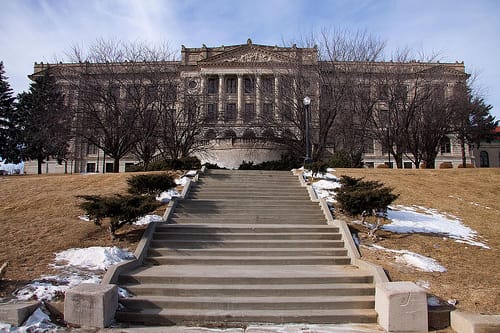
Over at the Education Next blog, Martha Derthick laments the decline of "stately" schools:
On the road in America, it has become hard to distinguish a public school from a post-industrial factory. The schools are the ones with yellow buses parked outside.
The schools' transition from stately, which was characteristic of the early 20th century, to sterile has several explanations: the spread of modernism generally, the devaluation of public architecture in particular (city halls have been victims too), the physical growth of schools through both district consolidation and population increase, and fiscal pressures in the public sector.
Whatever the reason, today's schools rarely invite respect. Once aspiring to be temples of learning, they lack symbolic connection to their function-unless we suppose, with Diane Ravitch, that No Child Left Behind turned schools into testing factories.
Derthick specifically highlights the turn-of-the-twentieth-century school buildings in Ohio's Queen City (which are also featured in 2001's An Expression of the Community: Cincinnati Public Schools' Legacy of Art and Architecture):
That schools in the early 20th century could be more than stately-they could actually be places of rare beauty-is suggested by the extraordinary history of Cincinnati, where schools incorporated fine art in the form of paintings, fountains, stained glass, tile decorations, and other architectural ornaments.
The decline of stately schools has been hastened here in Ohio, where over the past decade the state has poured billions of dollars into renovating and replacing our public schools with the new, modernist buildings Derthick describes. A visit to any of Ohio's newly built schools will confirm that we've moved away from buildings of beauty to buildings of function. I'm certainly in favor of preserving the historic buildings whenever possible, but I see the upside to modernization as well. I attended elementary and high school in the Buckeye State in early 20th century buildings much like those she talks about, both of which have since been replaced with new facilities. But alongside the aesthetic transformations have also come much-needed improvements for modern-day learning.
Today's students who grow up in my hometown may not take their lessons amidst grand architecture and breathtaking art. But they also don't have to trek across a playground and parking lot during cold Ohio winters to eat lunch (my elementary school did not originally have a cafeteria so one was added--in a separate building), and today, students with disabilities have full access to their school (my three-story high school had no elevator, so wheelchair-bound students had no choice but to commute to a neighboring district for classes). That might be a fair trade-off.
Image courtesy of Bill Davies.
